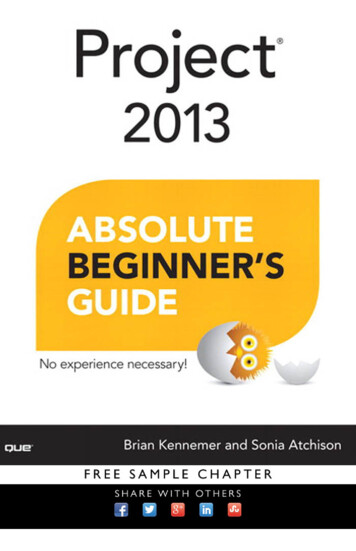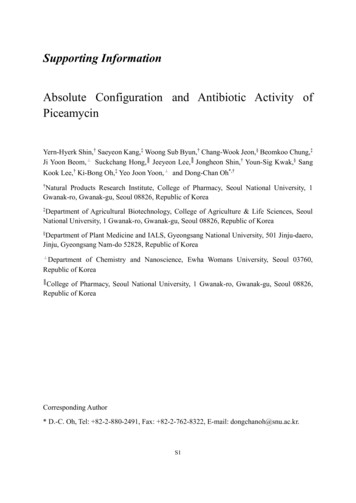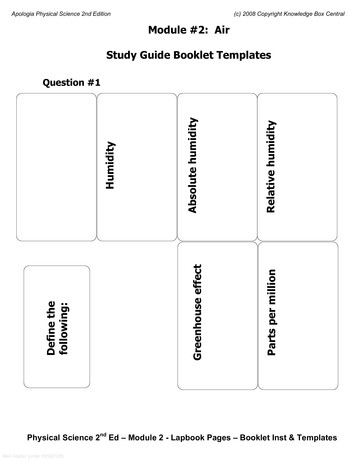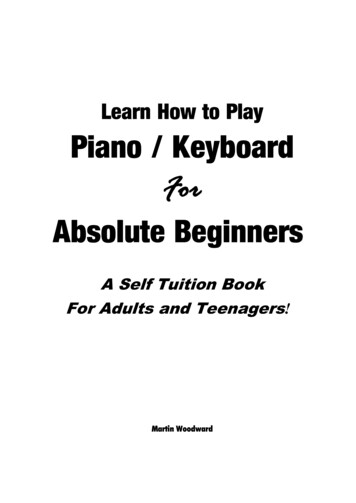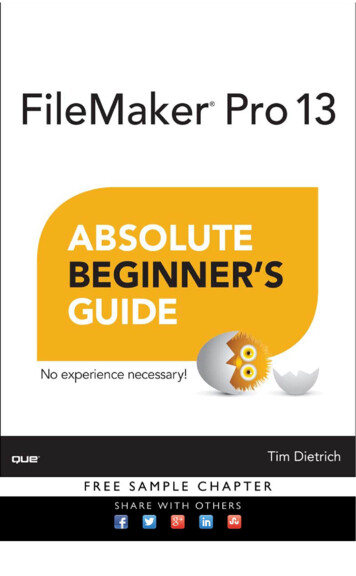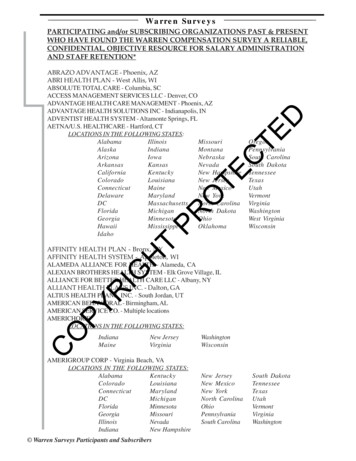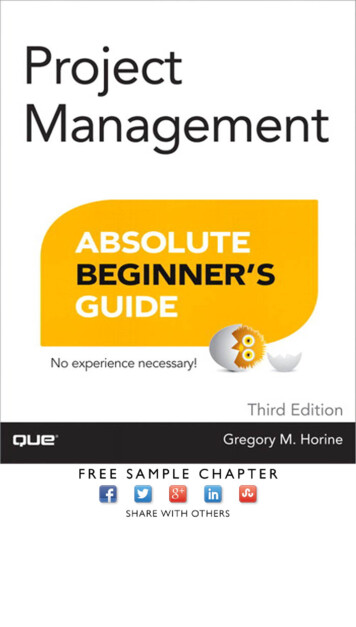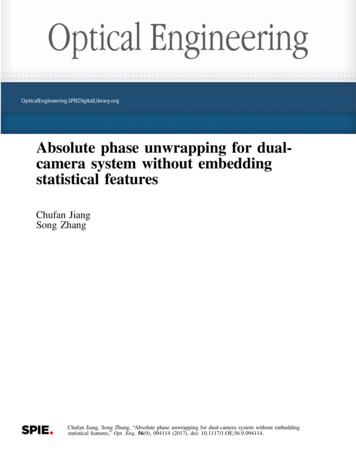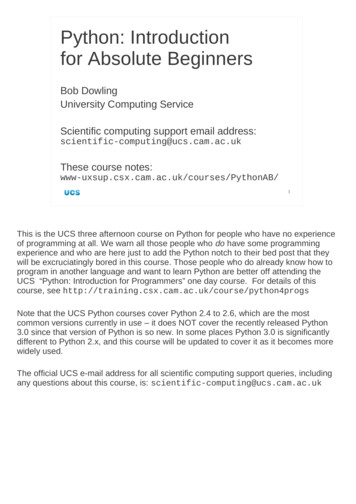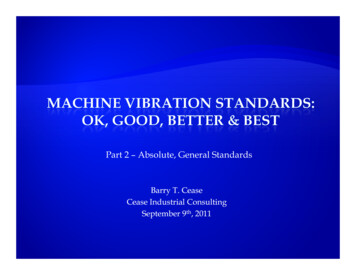
Transcription
Part 2 – Absolute, General StandardsBarry T. CeaseCease Industrial ConsultingSeptember 9th, 2011
1) ABSOLUTE, GENERAL (OK)2) ABSOLUTE, MACHINE SPECIFIC (GOOD)3) COMPARATIVE (BETTER)4) HISTORICAL STANDARDS (BEST)Cease Industrial ConsultingMachine Vibration Standards: Ok, Good, Better & Best2
1)2)3)4)5)6)7)8) These standards represent a starting point or rough gauge to apply to mostmachinery using an absolute vibration reference level by machine condition that isbased on both experience & historical data across many industries and machinetypes. Some examples are as follows:IRD 10816 Charts (Casing Measurements)Bernhard Chart (Casing Measurements)Vibration Institute Standards (Casing Measurements)Update International Standards (Casing Measurements)Blake Chart (Casing Measurements)ISO 10816-1 Standard (Casing Measurements)API 612 Standard (Shaft Displacement)Dresser-Clark-Jackson Chart (Shaft Displacement)PROS: No prior machine history is required to perform a general assessment of amachine’s health.CONS: Fail to account for the vast differences between machine types, bearing types,stiffnesses, system mass, base types, machine speeds, loading, etc.Cease Industrial ConsultingMachine Vibration Standards: Ok, Good, Better & Best3
At or below 0.08 ips-pk isgood for generalmachinery. At or above 0.314 ips-pkis rough for generalmachinery.Cease Industrial ConsultingMachine Vibration Standards: Ok, Good, Better & Best4
About 1 g’s-pk or belowrepresents goodoperation for mostmachinery. About 3 to 4 g’s-pkrepresents the limit ofgood to fair operation formost machinery.Cease Industrial ConsultingMachine Vibration Standards: Ok, Good, Better & Best5
Velocity:1) Below 0.20 ips-pk is considered goodto fair.2) Above 0.20 ips-pk is consideredrough.Acceleration:1) Below 3 to 6 g’s-pk is consideredgood to fair.2) Above 6 g’s-pk is considered rough.Foundation Type: Suggestion is made toreduce measured levels by 40% tocompensate for isolated or weakfoundations.Cease Industrial ConsultingMachine Vibration Standards: Ok, Good, Better & Best6
Vibration Institute, General Standards[8]Update International, General Standards[9]Machine ConditionOverall Vibration,RMS Velocity(ips-rms)Overall Vibration,Peak Velocity(ips-pk)Machine ConditionOverall or 1x RPMVibration LevelHigher FrequencyVibration (BearingFrequencies)Acceptance of newor repairedequipment 0.08 0.16Dangerous10.4Very Bad0.60.2Unrestrictedoperation – normal 0.12 0.24Bad0.30.1Surveillance0.12 – 0.280.24 – 0.7Mildly Rough0.20.07Unsuitable foroperation 0.28 0.7Good, Acceptable0.10.04Very Good0.050.02Precision, VerySmooth0.01-0.020.005Cease Industrial ConsultingMachine Vibration Standards: Ok, Good, Better & Best7
Velocity:1) Below 0.06 ips-pk No Fault.2) Below 0.20 ips-pk MinorFault.3) Above 0.20 ips-pk Some Fault.4) Above 0.63 ips-pk AcuteFault.5) Above 2 ips-pk Danger.Acceleration (Freq. Dependent):1) Below 1 g’s-pk No Fault.2) Below 2-3 g’s-pk Minor Fault.3) Above 10 g’s-pk Acute Faultto Danger.Service Factor provides a way toadjust levels for machine criticality.Cease Industrial ConsultingMachine Vibration Standards: Ok, Good, Better & Best8
"Derived Peak"RMS VibrationRMS VibrationVibrationVelocity (mm/s) Velocity (ips-rms) Velocity (ips-pk) Class 1 Class 2 Class 3 Class 0DDDC281.101.56DDDD451.772.51DDDDZone A - Newly commissioned machinery. Excellent Condition.Zone B - Good. Acceptable for unrestricted, long-term operation.Zone C - Unsatisfactory for long-term, continuous operation (alert level).Zone D - Bad. Sufficient severity to cause long-term damage to machine (alarm level).Class 1 - Very small machinery or parts of machinery (20 HP or below).Class 2 - Small machinery (20-100 HP) on rigid foundations.A complete copy of thisvibration standard isavailable from the ANSIwebsite at the following:http://webstore.ansi.org/Class 3 - Large machinery mounted on rigid & heavy foundations.Class 4 - Large machinery mounted on relatively soft foundations.Cease Industrial ConsultingMachine Vibration Standards: Ok, Good, Better & Best9
TheAPI 612 specificationoffers a quick way togauge the severity of shaftvibration in displacement(mills-pk-pk). Oftenused whencommissioning newequipment for service. Thespec is simply givenby applying the formulashown at right. Allyou need to know isthe machine rpm to obtainthe spec.Cease Industrial ConsultingMachine Vibration Standards: Ok, Good, Better & Best10
TheDresser-ClarkJackson chart like theAPI spec gives a quick,overall assessment ofmachine condition ifthe machine rpm isknown. Resultsare similar tothose from the APIspec.Cease Industrial ConsultingMachine Vibration Standards: Ok, Good, Better & Best11
6)IRD Mechanalysis, Vibration Technology 1 Manual, Chapter 2, Basics Of Vibration,IRD Mechanalysis, 19887)Bernhard, David, Machinery Balancing, 2nd Edition, Chapter 1, VibrationFundamentals, David Bernhard, 19988)Eshleman, Ron, Basic Machinery Vibrations, Chapter 5, Machine ConditionEvaluation, VI Press, IL, 19999)Buscarello, Ralph, Practical Solutions to Machinery & Maintenance VibrationProblems, p. 156, Vibration Tolerances, Update International, CO, 199110)ISO 10816-1, Mechanical Vibration – Evaluation Of Machine Vibration ByMeasurements On Non-Rotating Parts – Part 1: General Guidelines, First Edition1995-12-15, ISO, Switzerland, 199511)American Petroleum Institute, API 612 - Special Purpose Steam Turbines forRefinery Service, Washington, DC, 1987Cease Industrial ConsultingMachine Vibration Standards: Ok, Good, Better & Best12
Cease IndustrialConsulting MachineVibration Standards: Ok, Good, Better & Best6. Acceleration: 1) Below 3 to 6 g’s-pk is considered good to fair. 2) Above 6 g’s-pk is considered rough. Foundation Type: Suggestion is made to reduce measured levels by 40% to compensate for isolated or weak foundations.
